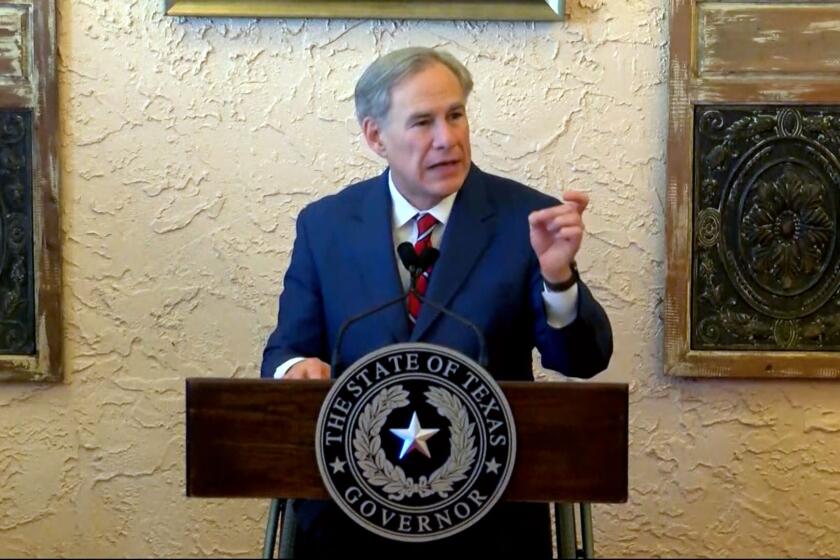Column: America is in the grip of a right-wing minority

- Share via
Republicans and conservatives are fond of the shibboleth that “America is a republic, not a democracy.” Boiled down to its essence, the phrase is a justification for awarding a strong voice in government to minority political views.
We are now at a stage where the minority is taking over. Worse, it’s an extremist minority that has exploited imperfections in our system of government to impose retrograde policies on the rest of the country.
For the record:
11:32 p.m. June 28, 2022A previous version of this column said the Supreme Court voted 6 to 3 to overturn Roe vs. Wade; the vote was 5 to 4. It also said the Roe decision was in 1974; it was in 1973.
No better example exists than the string of far-right decisions handed down recently by the U.S. Supreme Court, most prominently in its decision overturning the 50-year precedent protecting women’s reproductive health rights via the 1973 decision in Roe vs. Wade.
A state-by-state analysis by public health professionals shows that States with the most restrictive abortion policies also continue to invest the least in women’s and children’s health.
— Dissenting justices in Supreme Court abortion ruling
But rulings overturning restrictions on gun rights — including the more than century-old New York law invalidated by the court last Thursday, as well as actions endorsing restrictions on voting, are symptoms of the same pathology.
Gerrymandering by GOP forces has cemented minority control of state legislatures.
Get the latest from Michael Hiltzik
Commentary on economics and more from a Pulitzer Prize winner.
You may occasionally receive promotional content from the Los Angeles Times.
In Wisconsin, where voter registrations are about evenly divided between Democrats and Republicans, the GOP is virtually assured of winning two-thirds of the legislative seats, thanks to a redistricting map drawn by Republicans and endorsed by a Republican-dominated state Supreme Court.
The Supreme Court’s drift toward the hard right has dire implications for the court itself and American society and politics at large. Let’s take them in order.
History tells us that bad things can happen to an institution that loses its public credibility. The decline of the Supreme Court’s reputation for trustworthiness has been long in coming but quickened during the last few years.
We observed recently that a series of decisions sharply at odds with public opinion has shown the court to be “out of step with the American people,” as Shira A. Scheindlin, a former federal judge in New York, told me earlier this month after the decision on Roe vs. Wade had been leaked but before it was formally handed down.
How far out of step? The 10 states in which public opinion polls show a majority of respondents oppose abortion rights have about 11% of the U.S. population, yet their approach has been turned into law by the Supreme Court.
Abortion rights are favored by more than 50% of adults even in most states that are rushing to put the court’s ruling into effect by banning or heavily restricting abortion, according to political scientists Jake Grumbach and Christopher Warshaw.
Trump’s legacy rests not on his policies but on the right-wing judges he placed on the federal courts.
Public opinion generally favors abortion rights and tighter gun controls, both of which are flouted by the court’s recent decisions.
The Pew Research Center found in February that only 54% of respondents had a favorable view of the court, down from 69% in mid-2019. The latest figure, the Pew pollsters reported, was “among the least positive in surveys dating back nearly four decades.”
Another new low was reported on Thursday by the Gallup Organization, with only 25% of the public expressing “a great deal” or “quite a lot” of confidence in the court. That was five points lower than the previous low, reached in 2014.
Even among Republicans, who generally have favored the court’s conservative decisions, its standing was at a low ebb, with 39% expressing confidence in the court, down from 53% in 2010. (The latest figure was 25% among independents and 13% among Democrats.)
The Gallup poll-taking was completed on June 20; polls taken after the abortion decision were also dire. A CBS News/YouGov poll taken on Friday and Saturday found that 59% of all respondents and 67% of women disapproved of the decision. More than 55% of respondents expressed the conviction that the court would move on to restrict same-sex marriage and access to contraception.
The court’s rulings have raised the profile of proposals to redress its ideological balance, whether by expanding the court to dilute the weight of the current conservative majority or imposing term limits to ensure that its membership more closely reflects public opinion.
The idea of imposing a term limit on Supreme Court justices is gaining traction.
According to a Politico/Morning Consult poll taken after the abortion decision, both ideas have been gaining public support, with 62% of respondents strongly or somewhat supporting term limits, and court expansion garnering plurality support of 45% approval versus 38% disapproval.
The decline in public standing should be worrisome for the court because it could knock away one of the pillars that allowed the court to survive the last concerted attempt at a restructuring. That was Franklin Roosevelt’s “court-packing” scheme of 1937, undertaken after the court overturned several New Deal initiatives and other reforms, such as a New York state minimum wage law.
Roosevelt failed, according to historian William E. Leuchtenburg, because he “attacked one of the symbols which many believed the nation needed for its sense of unity as a body politic.” That belief, however, has now disappeared.
Warnings about the consequences of a decline in public standing are coming from inside and out of the courthouse.
In their dissent to the abortion decision, Justices Stephen G. Breyer, Sonia Sotomayor and Elena Kagan observed that the decision did more than eliminate “a 50-year-old constitutional right that safeguards women’s freedom and equal station. ... It breaches a core rule-of-law principle, designed to promote constancy in the law ... [and] places in jeopardy other rights, from contraception to same-sex intimacy and marriage.”
The notion of expanding the Supreme Court has been gaining traction lately, thanks in part to the court’s distinct rightward tilt, its increasingly partisan character, and its apparent hostility to abortion rights.
They concluded: “Finally, it undermines the Court’s legitimacy.”
Harvard Law professor Noah Feldman put the crisis more bluntly. He called the pernicious abortion decision “an act of institutional suicide for the Supreme Court. The legitimacy of the modern court depends on its capacity to protect the vulnerable.”
As for the effects on society generally, Republican officeholders have seemed remarkably disdainful of the implications for the health of women and children of repealing the right to abortion.
The 26 mostly Republican-controlled states that are poised to restrict abortion in the wake of the Supreme Court decision or that have already done so generally rank in the bottom half of nationwide measures of infant mortality and worse than the national average of maternal mortality.
As the dissenting justices wrote, “a state-by-state analysis by public health professionals shows that States with the most restrictive abortion policies also continue to invest the least in women’s and children’s health.”
A judge’s ruling blocking the new Texas abortion law lays out how malevolent it is.
Mississippi, which brought the lawsuit on which the court ruled Friday, is a poster child for official indifference to women’s and children’s health. The dissent noted that “health outcomes in Mississippi are abysmal for both women and children.” The state ranks worst in the nation on infant mortality and its maternal death rate, 33.2 deaths per 100,000 live births, is nearly twice the national average.
These figures make a mockery of assurances voiced by Mississippi Gov. Tate Reeves that “the next phase of the pro-life movement is focusing on helping those moms that maybe have an unexpected and unwanted pregnancy ... [and] making sure that those babies, once born, have a productive life.”
History provides no evidence that Reeves is serious. As the dissent observed, Mississippi “has strict eligibility requirements for Medicaid and nutrition assistance, leaving many women and families without basic medical care or enough food. Although 86 percent of pregnancy-related deaths in the State are due to postpartum complications, Mississippi rejected federal funding to provide a year’s worth of Medicaid coverage to women after giving birth.”
The court’s recent decisions suggest that the conservative majority came to these cases with a preexisting determination to restore in American society a golden age in which a privileged minority dictated political standards and could protect their own prerogatives without interference.
They may defend their decisions by finding justifications in the text of the Constitution, but that’s not a serious analysis. The gun rights ruling promoted “a dark and cynical view of society” in which “danger lurks behind every corner, threatening to lunge at our heels, and the best we can do is arm up,” wrote New York lawyer Liza Batkin. “It’s a Wild West worldview in the guise of an originalist, text-bound decision.”
The options for restoring abortion rights at the federal legislative level, where things must happen to “codify Roe,” as the principle is labeled, are limited but real. One is to build on the Women’s Health Protection Act, which has been passed by the House but blocked in the Senate. The measure would prevent states from imposing excessive restrictions on abortion providers to interfere with women’s reproductive health choices.
A reworked bill could set acceptable limits on abortions, say by restricting them to the first trimester of pregnancy, but also protect providers acting to safeguard the health of the mother and to ensure abortion rights in cases of rape or incest. The measure could also prohibit states from penalizing women who seek abortions outside the state or those who help them do so.
The chief obstacle to such a law is politics. Passing it in the Senate would probably require ending the filibuster — now may be the time.
It’s conceivable that the Supreme Court could invalidate the new law, but that would be a more radical step than the current court majority has been willing to take even in the abortion and gun rights cases because it would mean reinterpreting the Constitution’s commerce clause, which gives Congress the exclusive authority to regulate interstate commerce.
“Sure, the SCt could chuck the caselaw in the trash,” law professor Julian Davis Mortenson of the University of Michigan tweeted after the abortion ruling. “But that’s what it would take: radical change — with implications far beyond abortion.”
Though this court has lurched far to the right, this might be a bridge too far — especially if its public legitimacy continues to crumble. After all, it was the threat of a deterioration in its public reputation that prompted the 1930s court to reverse itself in its approach to liberal reforms to stave off FDR’s court-packing scheme.
There are signs that even moderates on Capitol Hill are unnerved by the radicalism of the Supreme Court. After the abortion decision was announced, Sen. Joe Manchin III (D-W.Va.) said that he would support a bipartisan effort to “put forward” legislation to “codify the rights Roe v. Wade previously protected.”
Can the Supreme Court continue to turn the clock back? In the short term, the damage has been done. In the longer term, it is standing in front of a powerful tide.
“The long arc of American history has bent more steeply towards gender equality in the past few decades,” wrote 154 economists in a friend-of-the-court brief in the abortion case. The trend line has been broken at the moment, but not forever.
More to Read
Get the latest from Michael Hiltzik
Commentary on economics and more from a Pulitzer Prize winner.
You may occasionally receive promotional content from the Los Angeles Times.















